The most colourful bird in the corvid or crow family, jays have vibrant pink and punky blue colouring. Despite their appearance the jay is a secretive bird, and can often be found in woodlands.
Its Latin name, Garrulus glandarius, roughly translates as ‘chattering acorn gatherer’ and it has a loud, screaming-like call.
Crow species tend to be intelligent birds that can adapt to a variety of habitats and food sources, and the jay is no exception.
Thanks to the jay's love of acorns, tens of thousands of new oak trees germinate each spring across the country as the bird drops and plants acorns.
Learn more about British bird species such as blackbirds, robins, tits and finches.
What does a jay bird look like?
A member of the corvid family, the jay bird's pink, blue and white feathers are a flamboyant burst of colour, reflecting a different genetic make-up to its more sombre-suited cousins, such as the crow, rook and jackdaw.
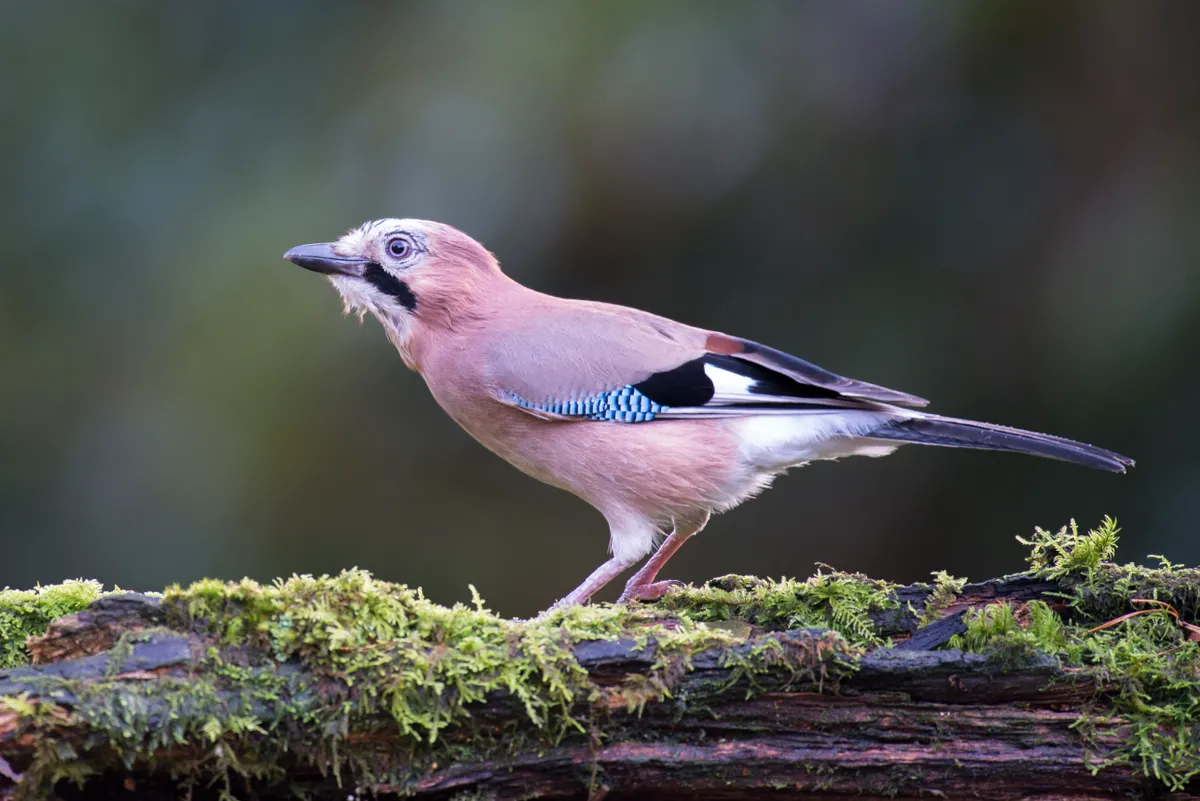
How big is a jay?
Jays weigh around 170g and measuring 35cm from tail to beak.
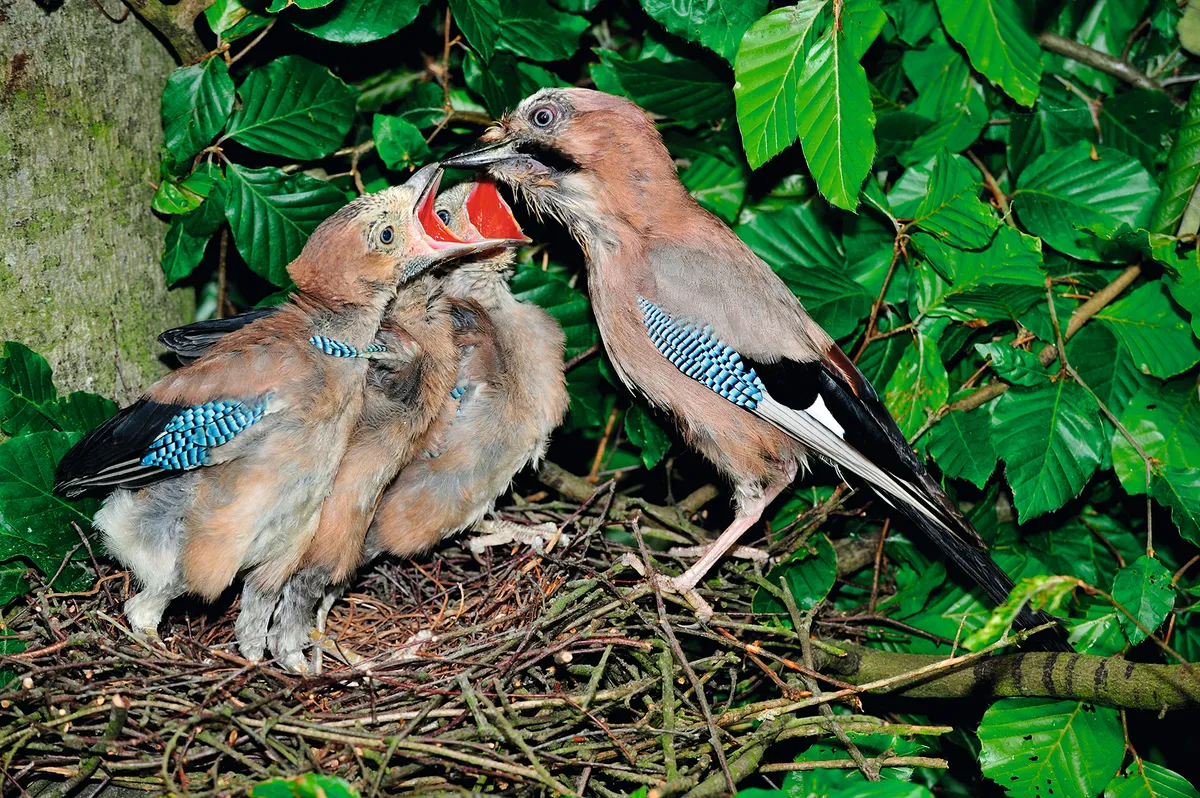
Jay population in the UK
The UK has a stable population of around 170,000 pairs of breeding jays and on average they live for four years, although the oldest ringed bird was over 16 years old.
Jays mate for life, building a messy-looking nest in April that is a tumble of twigs, roots and animal hair.
They lay a clutch of four to five eggs, which are bluey-green with buff speckles and small in relation to the adult bird. The chicks fledge after around 20 days.
When is the best time to see jays?
Usually shy and secretive, jays are more visible in the autumn as they work hard to cache acorns, often flying many miles from their home range in hunt of oak trees.
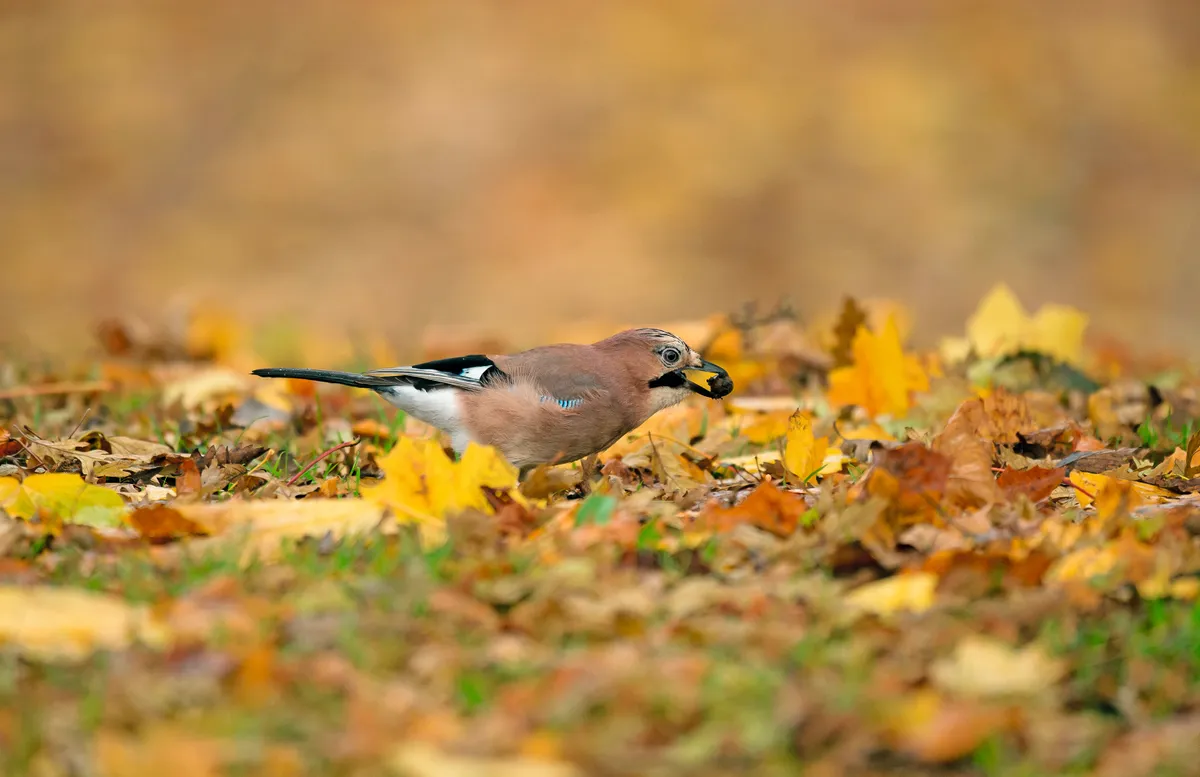
Where to see jays
Jays live in both broadleaf and coniferous forests and woodlands, eating acorns, seeds and fruit, as well as insects, eggs and the occasional young bird. They are widespread across the UK, with the exception of northern Scotland. Although they prefer woodland, they can be coaxed into the open by well-stocked garden feeders. They are an irruptive species – a poor harvest of acorns on the continent can see coastal areas suddenly swamped by as many as 3,000 jays searching for food.
Jays and mimicry
Jays are also excellent mimics, with tawny owls and buzzards among their favourite impersonations. Exactly why they do this is not known, although it’s likely that the larger their repertoire of sounds and tweets, the more attractive they are to potential mates.
Similar birds to jays
Waxwing
Another irruptive species that arrives in the UK for so-called ‘waxwing winters’, when there aren’t enough berries to eat on the continent.

Nuthatch
A much smaller forest dweller but with similar pinky-brown plumage.

Hoopoe
A rare and occasional visitor to the south coast. The size of a thrush with dramatic black-and-white wings, a long curved bill and showy crest.

What is the relationship between jays and oak trees?
Like so many corvids, the jay has been indiscriminately persecuted as a pest for centuries, but it is now being hailed as the new champion of reforestation in the UK. By burying thousands of acorns each year, the jay is playing a crucial role in passive rewilding, when nature is left to its own devices to slowly reclaim land that was once managed and farmed.
Forestry consultant Rick Worrell first became intrigued by jays when he noticed hundreds of oak seedlings in the small birch wood behind his home. “We have a very good view across the Tay Valley, and from there I couldn’t see a single oak tree,” he explains, “and that’s what kind of blew my mind, that these acorns are springing up... in a situation where you couldn’t see the oak woods that they had come from.” Who was planting the oaks? Jays.
In 2015, Rick teamed up with the University of Edinburgh to conduct the first UK-based research into the jay’s symbiotic relationship with the oak, and the crucial role the bird plays in dispersing acorns and sparking new woodland growth. A key conclusion of the research was that, rather than worrying about oak woods not regenerating in situ, woodland managers needed to look further afield, identify the sites where jays were stashing acorns and start to give these areas some form of protection. “We all knew jays buried acorns, we just didn’t know the scale,” says Rick. “The oak has got this fantastic dispersal agent… it’s a pretty extraordinary story.”
It’s an ancient story, too. At the end of the last Ice Age around 11,000 years ago, much of the continent’s flora and fauna had been forced into refugia – unfrozen pockets of land that clung on in Spain, Portugal and parts of the Balkans. Then, over the course of the next few thousand years, the oak managed to spread again, as jays slowly moved acorns ever northwards, even bridging the still-frozen Channel to reach what is now the UK.
This role in supporting new oak growth has also been highlighted in the results of a long-term study into natural regeneration. The research first started 60 years ago and was carried out on two agricultural fields close to Monks Wood National Nature Reserve in Cambridgeshire, an ancient woodland first recorded in 1279. The older field was full of barley until 1961, the other was grassland and abandoned in 1996. “We decided to just let it go and watch what happens,” explains ecologist Dr Richard Broughton from the UK Centre for Ecology & Hydrology, which has taken on the research. “It was the start of passive rewilding.”
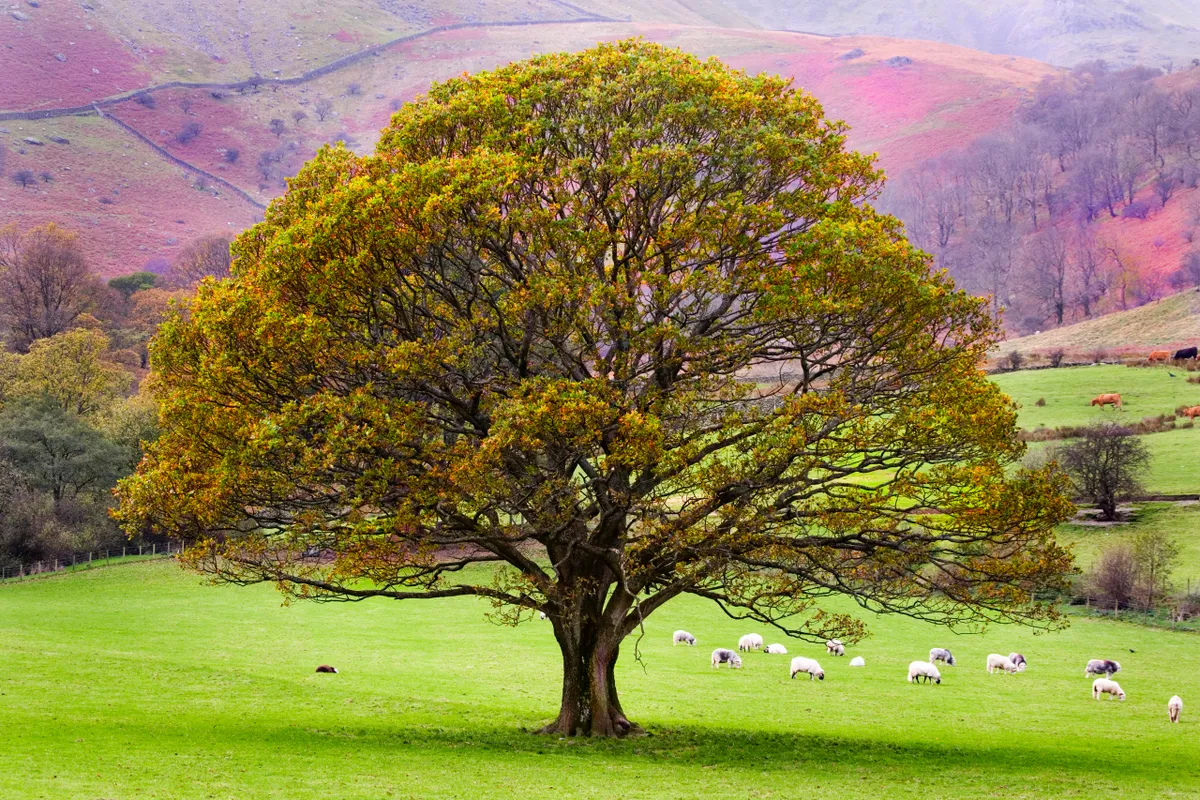
The study showed that after just 15 years, the fields had become wildlife-rich scrubland and, within 50 years, a closed canopy woodland of native oak, ash and field maple had taken over the barley field. Over half of the new trees were oak, says Richard, compared to less than 20% in the neighbouring woodland. “This was almost completely down to jays,” he says. The birds had raided the nearby wood for acorns and buried them in
the field.
Incorporating this type of passive rewilding into national planting targets could save significant amounts of money. The Government’s ambitious plan is to replant 30,000 hectares of woodland a year by 2025. While natural regeneration won’t work everywhere, Richard says, “There’s no point planting next to a woodland, because if you just leave it, you get it for free. Planting trees should be limited to those areas where there’s no natural woodland close by, and therefore no jays,” he says.
There are other benefits to passive rewilding, Richard adds. The trees are adapted to the local soil and climate, while imported trees can harbour diseases and have often been grown in environmentally damaging peat. Planted naturally, trees also have stronger root systems, making them far more resistant to drought, while the jays’ work can save on labour and transport costs. It all makes for a pretty compelling case.

So how does it work? While trees like birch and ash rely on wind to distribute their seeds, the heavy acorn is going nowhere unless someone gives it a lift. In good, or mast years, an oak can produce up to 10,000 acorns; while most will drop to the woodland floor to be scavenged by mice, squirrels and pigeons, many are also grabbed by jays.Each jay can scatter thousands of acorns every autumn, on average taking them around 100m from the mother tree, although distances of up to one kilometre aren’t unknown.
Jays prefer to stash their acorns in scrubland, where they are easier to find again, even using vertical ‘markers’, such as saplings, to make it easier for them to retrieve their bounty. This intelligence is matched by an incredible memory and while some acorns will be stolen by mice, most are reclaimed at a later date. But given the huge numbers involved, the small percentage of acorns overlooked is enough to make a significant difference to oakland regeneration. Taking the acorns away from the heavily shaded forest floor benefits the oak too, with the extra light encouraging the seeds to germinate. Add those blown-in seeds from ash and birch, and you soon have the start of a young woodland.
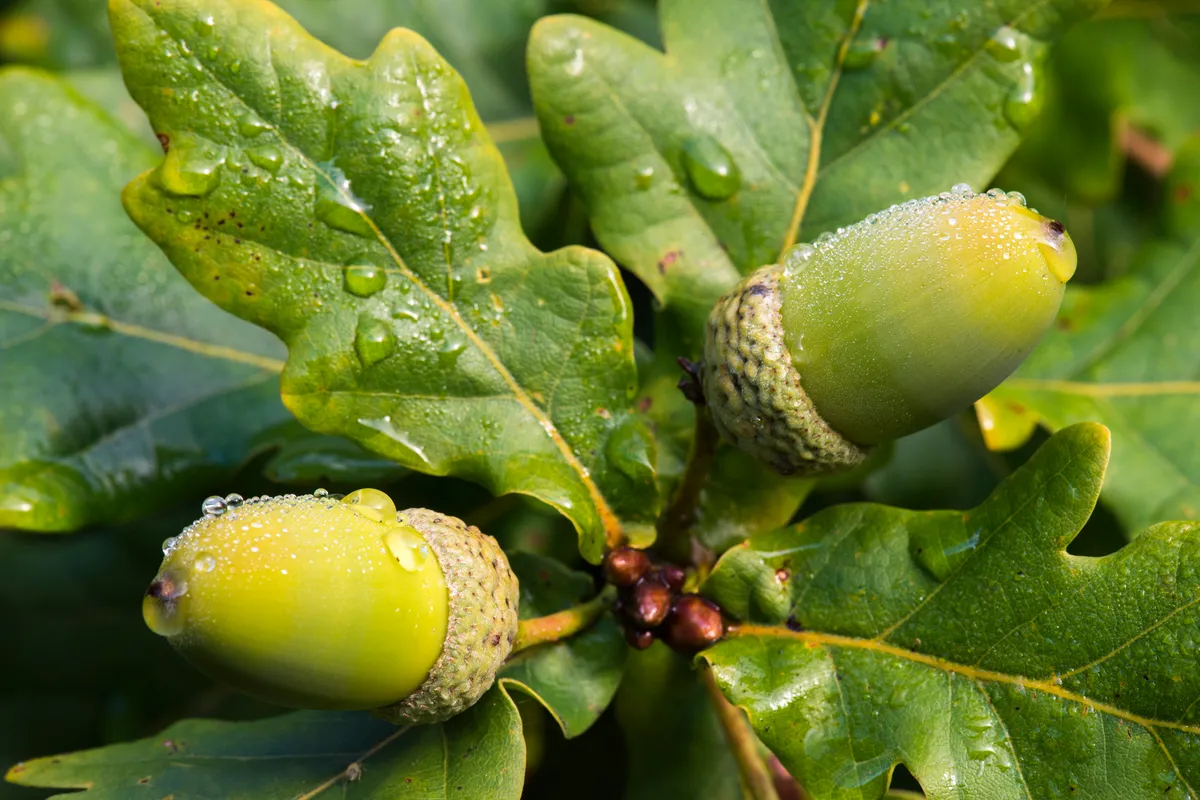
In managed plantations, many of these new saplings are encased in plastic sheaths to stop deer and rabbits nibbling the growing shoots. These cases are eventually discarded as the trees grow, littering the countryside with more plastic waste. But nature has a solution for this, too.
Enter the thrush, which also forages on the same open ground as jays, looking for worms. Its droppings are full of seeds, and once these germinate, dense thickets of hawthorn and bramble spring up, providing the oak saplings with natural protection from hungry herbivores.
“Gradually the oaks will shade out the thickets as they form a canopy and the thicket then becomes the woodland understorey,” explains Richard. “You get this really natural, multi-level woodland – something you don’t get from planting rows of trees.”
So, do we need to reconsider our relationship with the jay? “Like so many corvids, the jay has been demonised,” says Richard. “It’s very difficult to change mindsets.”
Rick agrees. “Anything that is a corvid is a target,” although having seen their importance to forests, “some European countries are protecting the jay,” he adds.
In the UK, the law around killing jays is opaque at best. They are still part of a Defra general licence on wildlife management, although they can only be killed on a conservation basis if they are predating a set list of other woodland birds, including willow tits and wood warblers. Yet there is no onus on the shooter to provide proof or justification for the killing and little appetite by the authorities to investigate any illegal shooting.
While jays do predate birds’ nests, says Richard, studies show there is no evidence they are driving decline in the bird population. The same, however, cannot be said of habitat loss. “The huge benefits that jays provide in natural colonisation by dispersing tree seeds, especially acorns, helps to create more woodland habitat for all wildlife and far outweighs any impact of predation,” he adds. “We should give jays protection, and a lot more respect.”

